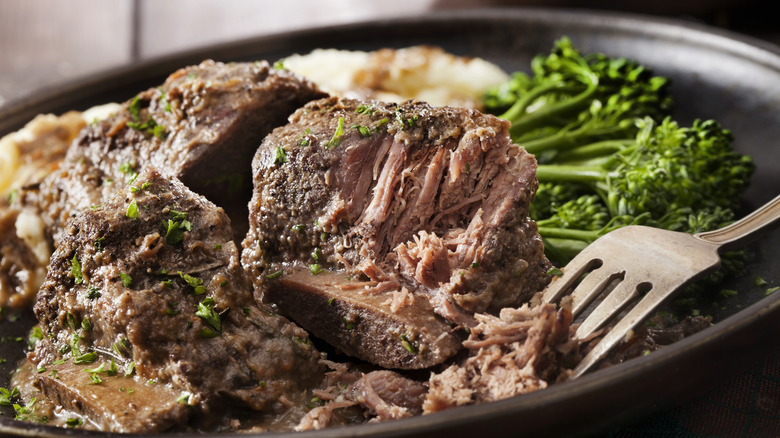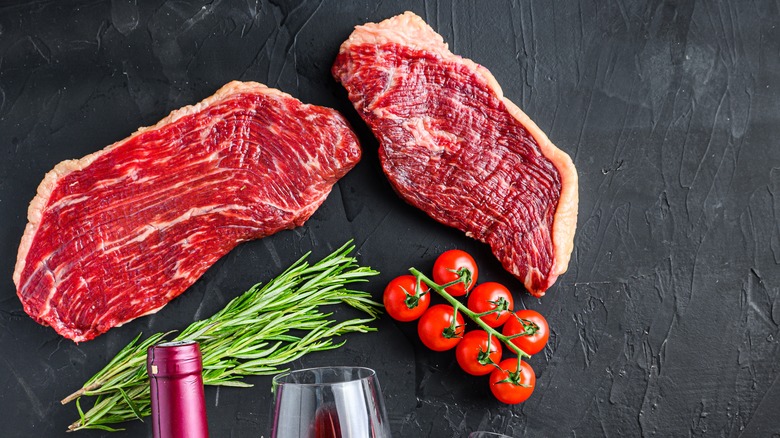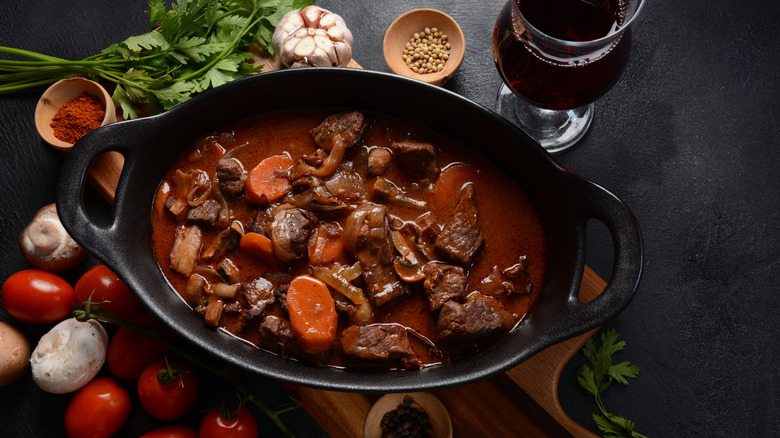The Best Inexpensive Cut For Stunningly Tender Braised Beef
When it's steak night at your place, it can be worth it to splurge on a top-quality ribeye, but for tender and delicious braised beef, you don't need to use an expensive cut. Braising beef slowly at a low temperature is a great way to transform tougher cuts into juicy pieces of meat. The braising liquid, such as broth with perhaps some red wine or beer, adds even more rich flavor to the finished dish. Suffice to say, even cheap and tough cuts can turn out delicious.
Beef chuck or shank are good choices, as these are flavorful yet tough hard-working muscles on the cow, as opposed to softer (and more expensive) cuts that don't get a lot of exercise. To get more creative, though, try going for a beef round, which comes from the rear legs of the animal. At the butcher's, you'll be able to purchase both "bottom round" and "top round," and both work well for braising or stews, becoming soft and flavorful when slow-cooked.
Bottom round is slightly tougher and best for slow-cooking, while the top round is especially flavorful when braised, but both top and bottom cuts will develop a toothsome texture that is easy to shred apart with a fork. While round is pretty easy to cook overall, a few tips can make your dinner even more extraordinary.
How to braise top round for a fork-tender texture
Braising a delicious beef round starts with picking a piece of meat that is nicely marbled. Round is a lean cut, but should still have enough fat to make it flavorful and tender. Look for cuts with streaks of white fat throughout the red muscle. Seasoning and searing the meat in a pan before braising creates a much better flavor. This kickstarts the Maillard reaction, giving the beef a delicious brown crust.
The taste of the beef can be enhanced by a flavorful braising liquid. Try using beef broth, if you can get your hands on quality stuff that doesn't come out of a tin or box, or chicken broth as a good stand-in. Aromatics such as onions, carrots, and bay leaves are classic additions. Deglaze the pan you seared the meat in with stock or alcohol to add even more depth. Try red wine or perhaps a splash of Cognac, the fruity liquor Ina Garten uses to boost beef stew.
A low oven temperature of around 300 degrees Fahrenheit is ideal for braising top round, which could take several hours, depending on the size of the cut. The process may be lengthy, but it's necessary to break down the tough muscle fibers. The beef is ready once you can easily shred it with a fork. If you'd prefer to serve it in slices, let it rest it for a few minutes after cooking to make cutting easier.
Other beef cuts that work well for braised dishes
While top round is an affordable and tasty option for braising, if you can't find it at your local store, you have plenty of other choices. For a recipe like classic beef Bourguignon, try the cut called featherblade, which can be cut into chunks and will need only 90 minutes to become tender, in comparison to slow-cooking cuts. Or try stewing whole brisket — the point cut is especially delicious, thanks to its higher fat content.
Some tougher cuts tend to have more connective tissue that holds them together, and this breaks down beautifully when braised for spoon-tender results. Try a cut such as shank, which comes from the animal's thigh, for a slow-cooked Italian-style osso bucco. The aforementioned chuck roast also has tons of connective tissue that gains a melt-in-your-mouth texture over several hours of cooking.
If you're not sticking to a strict budget, you have even more options. Oxtails can be pricey, but are perfectly suited to low-and-slow methods of cooking. They contain tons of fat and gelatin for a rich texture and deep flavor. Try making braised oxtails and brown butter mashed potatoes for an elegant and indulgent feast that's packed with flavor. Or, for another choice that feels luxurious, go for bone-in shorts ribs for a classic and comforting braised beef option that's a guaranteed crowd-pleaser.



